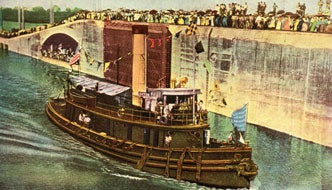 August 15, 2014, marked the 100th anniversary of the Panama Canal. The canal’s completion, one of the greatest feats of engineering by mankind, brings to light the impressive contributions of Rensselaer engineers who participated in connecting the oceans. Beginning with the Panama Railroad in 1855 and ending with the completion of the Panama Canal in 1914, Rensselaer engineers are peppered throughout this portion of history.
August 15, 2014, marked the 100th anniversary of the Panama Canal. The canal’s completion, one of the greatest feats of engineering by mankind, brings to light the impressive contributions of Rensselaer engineers who participated in connecting the oceans. Beginning with the Panama Railroad in 1855 and ending with the completion of the Panama Canal in 1914, Rensselaer engineers are peppered throughout this portion of history.
The Panama Railroad accommodated those eager to reach California for newfound gold. Gilbert Taylor (Class of 1844) was a general freight agent on the Panama Railroad throughout the 1850s and Walter Dauchy (Class of 1875) was employed in the freight department from 1875 to 1878.

Aniceto Garcia Menocal, Class of 1862.
Though the railroad satisfied many needs, a water route was the ultimate goal. Surveys were conducted and routes considered, and again Rensselaer engineers were involved. In 1870, President Ulysses Grant appointed Estevan Fuertes (Class of 1861) chief engineer to survey a route via Tehuantepec, Mexico. In 1872, Grant placed Aniceto Garcia Menocal (Class of 1862) in charge of mapping a route across Nicaragua. Another Rensselaer engineer, Frederico Garcia y Garcia (Class of 1872), was sent by the government of Peru in 1873 to verify a survey by Commander Selfridge for a canal route on the Isthmus of Panama.
Construction of the canal began with the French. When Lieutenant Lucien Wyse arrived on the isthmus to conduct a survey, the Colombian government assigned Pedro Sosa (Class of 1873) to the expedition as a scout engineer and chief of technical control and topography.
The French began work on the canal in January 1881. Rensselaer engineers continued to play a key role. Auguste Millet (Class of 1867) was chief of technical bureau in 1882, and then chief of section at Culebra (the mountain zone) from 1882 to 1883. John Henry Curtis (Class of 1873) began work in September 1883 as contractor for “the removal of Bohio Mountain.”
Unfortunately, all work on the canal ceased in 1889. Poor planning, yellow fever and malaria, and corruption all contributed to the bankruptcy that brought the French endeavor to ruin.
The United States was granted possession of the Canal Zone in 1903 by the Panama government. Between 1904 and 1914, seven Rensselaer engineers were involved in planning and construction. Walter Dauchy (Class of 1875) was appointed division engineer on the Culebra section in 1904. Ricardo Arango (Class of 1887), a Panamanian, was an engineer under both the Colombia and Panama governments. In 1904 he was division engineer in Ancon. Arango remained in Panama and became the chief engineer of the Republic of Panama. William Baucus (Class of 1887) was a civil engineer with the Municipal Engineering Department in Panama from 1904 to 1907, and was appointed consulting engineer for water works and sewerage systems by the Canal Commission.
 There were three Canal Commissions over the course of American construction and a Rensselaer engineer was on each commission. William Burr (Class of 1872) served on the First Canal Commission appointed by President Roosevelt in 1904. In 1905, Burr was appointed to the International Board of Consulting Engineers to choose what kind of canal would be constructed. In 1905, Rear Admiral Mordecai Endicott (Class of 1868) was appointed member of the Second Commission. Then, after Endicott resigned, Rear Admiral H.H. Rousseau (Class of 1891) was personally appointed by Roosevelt to serve on the Third Canal Commission.
There were three Canal Commissions over the course of American construction and a Rensselaer engineer was on each commission. William Burr (Class of 1872) served on the First Canal Commission appointed by President Roosevelt in 1904. In 1905, Burr was appointed to the International Board of Consulting Engineers to choose what kind of canal would be constructed. In 1905, Rear Admiral Mordecai Endicott (Class of 1868) was appointed member of the Second Commission. Then, after Endicott resigned, Rear Admiral H.H. Rousseau (Class of 1891) was personally appointed by Roosevelt to serve on the Third Canal Commission.
Under G.W. Goethals, chief engineer of the Panama Canal, Rousseau was appointed as his assistant, a position he held until 1914. Rousseau designed the dry docks, wharves, piers, ship repair shops, coaling plants, fuel plants, breakwaters, and floating cranes.
Before the Panama Canal was built, ships traveling from the Atlantic to the Pacific traveled around the southern tip of South America. The journey was 13,000 miles around Cape Horn from New York to California. The Panama Canal reduces the journey to 5,200 miles. Today, the canal accommodates 14,000 ships a year on average, with over 200 million tons of cargo, representing 5 percent of the world’s shipping. The engineers, who helped connect the oceans, changed the world.


